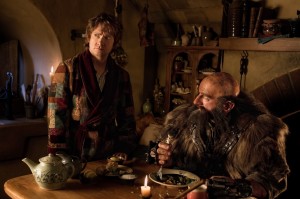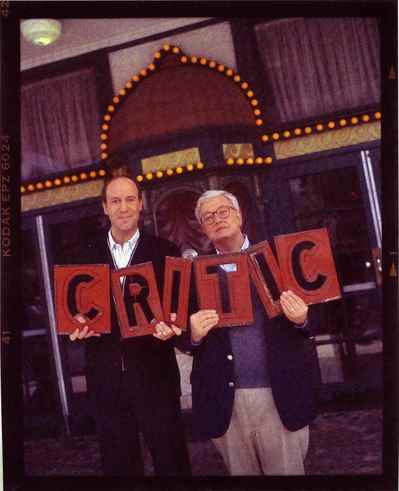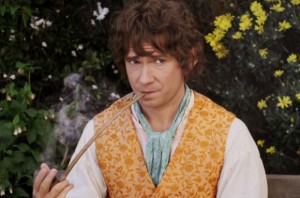BOFCA member Bob Chipman is an avid supporter of the latest development in theater projection, the controversial 48 frames per second. Here is his defense of Peter Jackson’s artistic decision for the first installation of THE HOBBIT:

I wish I had a more interesting (or, at least, less obvious) “defense” to mount of the 48FPS format than to go back to previous arrivals of new technology to filmmaking such as sound, color, automatic shutters, computer-generated imagery (CGI), widescreen and the like, but it really is the most accurate comparison that can be drawn in terms of this new tech, the reactions to it thus far and the cycle that is likely to follow.
Of course, it’s hard to divorce talk of the new tech itself — which, for the record, records digital footage at forty-eight frames per-second as opposed to the previous film standard of twenty-four frames – simply as a technology from its use in the production and (in some territories) release of THE HOBBIT. It’s the first feature to have been released in the format and, as one expects from a debut, the results are not altogether perfect: It’s principal benefit, an immediately-visible increase in sharpness and image clarity, is impressive from the start and occasionally becomes breathtaking when applied to the film’s wide natural New Zealand vistas or the detail-packed layout of Goblin Town; but the lack of familiar (from most people’s lifetime of watching movies at 24fps) motion-blur accompanying rapid movements creates a paradoxically overly-real and thus “unreal” effect in spots.
Perhaps the most notable (and easily the most ironic) drawback to the technology is that, as a sudden evolutionary leap, it has the effect of revealing previously inconsequential flaws in the technology that accompanies it: The entirety of fields like makeup, CGI, practical effects, set construction and props have all been built around the previous technological “ceiling” of 24fps, and as such the “seams” of each craft’s respective artifice have been dealt with under the assumption that they’d be “hidden” by the detail-limitations and motion-blur of the traditional format. As a result, the plastic, latex and foam-rubber origins of THE HOBBIT’s endless parade of inhuman features, bulk armor, shiny weapons and snarly beasts are readily apparent in a few sequences too many. Likewise, the aforementioned lack of motion-blur belies the fact that various camera movements are just that (camera movements) rather than the drift of one’s own gaze. It’s the cinematic equivalent of the tidal wave of “Whoa! When did [insert-television-personality-of-your-choice] get so old!?” that greeted the arrival of HDTVs.
What happened in that case (HDTV breaking the illusion of broadcast-television makeup) was what always happens: Fairly or not, when one technology in a given medium makes a leap forward (and let’s be very clear here, the sheer clarity and depth of field alone makes 48FPS a forward leap, as opposed to a novelty like the 3D which here accompanies it) the rest of the medium needs to play catch up. When magazines and comic books went from being printed on newsprint and pulp to glossy paper, layout artists and illustrators had to change and/or improve their craft now that the tendency of porous paper to absorb and blur small details was lost. When sound was introduced to filmmaking, everything from acting to screenwriting had to change. When color film came into being, cinematographers and costume designers had to re-learn their whole craft. It’ll “get done” for films in the 48FPS era, is the point of that; and what’s more, makeup, props, costuming and set design will get better for the experience.
There’s another point there, too: This always happens. And so it also goes for the “audience side” (though, let’s be clear once again, what we’re talking about so far is overwhelmingly the “film critic and hardcore cinephile side”) of the reaction. The most common negative response, thus far, to 48FPS film is that it “doesn’t look film” – by which the dissenter in question generally means it doesn’t look like traditional 24FPS film. Well, yes– of course it doesn’t. It’s not 24, it’s something new.
Now, however reactionary or shortsighted I might find some variations on this complaint, I’m not going to presume to tell anyone that they’re “wrong” to not like the way this new tech looks. Absolute critical objectivity in regards to art is a nice ideal, but the fact is we all have our turn-ons, turn-offs, preferences, comfort-zones and so forth. Most movie-lovers have spent their whole existence as such loving a cinematic “feeling” which has as much to do with semi-intangible elements like the “artifacts” of filmmaking technology (motion blur, film-grain, projector-flicker, etc); and it’s only natural that they should regard a new paradigm wherein one or more of those intangible “You. Are. Watching. A. Movie.” psychological cues has been removed as at best an off-putting change and at worst a degradation of quality – it’s the reason your digital camera still plays the recorded “click-whiiirrrr!” of a film camera’s shutter: Because a lifetime of experience has burned “that means you just took a picture” into your mental reflexes.
Speaking of digital cameras, the popularity of “Instagram,” an internet photo-sharing service that allows users to add photo-filters to digital snapshots, illustrates the power of this kind of visual sense-memory even better. The amusing paradox Instagram’s filters is that many of the “improvements” they offer to images are actually about adding image flaws (washed-out color, low exposures, etc) designed to make the images in question look “more like photographs;” i.e. make them look like they were taken with older, less-precise equipment the effect of which your subconscious has been taught to recognize as looking more authentically photographic. This is also the reason that video games – which have been processing their image-speeds at about sixty frames per-second for the better part of a decade now – frequently add an “artificial” motion-blur and image-degradation reminiscent of 24FPS film to animated sequences called “cutscenes” designed to move the storyline along, because doing so cues player/audience to think and feel “this looks like a movie, so take it as seriously as one.”
That’s also an element of the conversation that’s frequently overlooked: 24FPS hasn’t been to sole standard for a long time. Your DVDs and Blu-Rays, for example, are timed to run at approximately thirty frames per-second. Video-games, as mentioned, run at 60 (the actual game-playing parts of them, anyway); which is why THE HOBBIT’s moments of more “unnatural” speed and clarity are likely to be either received much more positively or not noticed at all by audiences under the age of 20 for whom such imagery is more familiar. Oh, and let us not overlook the gigantic technological elephant in the room: In nearly all of these cases, the “frames” in question… are at one stage of delivery or another entirely theoretical. They don’t exist. There are no frames.
An increasing number of feature films – yes, including 24FPS films – are not “filmed” at all: They’re shot on digital video. In addition, most major theaters are showing said films using digital video projectors, regardless of how they were shot in the first place. Since the advent of VHS tape, no home movie-viewing technology has utilized any kind of actual definitive “frames” (read: still images shot and projected at a speed so as to create the illusion of movement) in any way except as a unit of measurement for image speed. We use the analog concept of frames and frame-rates to measure these things not because they’re accurate to what we’re describing, but because it’s the most “universal” term by which we grasp the technological concept of moving pictures.
Oh, yes. About that. Motion Pictures. Remember that? That’s what we called this medium back before it was decided that it was more respectable sounding to say “film” or “cinema,” despite one of those referring to a part of the machinery and the other referring to a type of building. There were good reasons for that, to be sure – “cinema” sounds more like an art-form while “Motion Picture” recalls too readily the carnival gimmick origins of the form (“SEE! The fantastic Bearded Lady! MARVEL! At the miracle of MOVING Pictures!”); but Moving Picture is still the original, fundamental soul of this medium – not the technology by which the pictures are made to move or the venues in which they do so. To say that cinema (or whatever you’d like to call it) ceases to be cinema unless it is shot on film stock at twenty-four frames per-second and projected onto a theatrical screen is to say that a novel is not a novel unless it is printed in ink on paper and bound into a physical book, or that a painting is not a painting if it is painted on a wall (or a wooden slate, like The Mona Lisa) instead of canvas, or that Jimi Hendrix wasn’t a musician because his instrument required electric amplification.
I understand and sympathize with desires for artistic purity and comfort zones within mediums. I’m an avid player of video games in addition to a film-buff, and while I enjoy the modern high-definition marvels displayed on my HDTV (or my smartphone, or my Nintendo 3DS for that matter) my “happy place” within that medium will always be pixel-based graphics and “music” made from bleeping soundchips bound up in an arcade cabinet or a beige plastic NES console. So yes, I more than understand those for whom the “feel” of digitally-projected 48FPS cinema will never been as “transporting” (to a place of nostalgia or otherwise) as a reel of 35mm film shot and projected at 24 from a classic analog projector – after all, I’m the guy still buying paper books because it “feels right.”
But that this is “The End?” That 48FPS represents the replacement of “dreamlike” traditional film imagery with some low, crude, television-esque usurper? No, I can’t go there. The whole history of technological evolution within the medium is against it.
Every new form taken by Motion Pictures has brought with it changes that made this or that well-liked element of the previous form less widely utilized, yes – but the benefits have nearly always outweighed the loss (or “lessening,” really.) Sound was a cheap gimmick (that briefly put crippling restrictions on cinematography,) until sound designers began to work miracles with ambient noise and multiple channels. Color removed the instant-abstraction of monochrome filmmaking, until cinematographers learned how much more mood and depth could be conveyed by tinkering with color theory. CGI was an expensive techie’s toy, until it could be made to conjure whole worlds (and has become, ironically, a great democratizer of the medium, allowing clever independents to craft epics with limited manpower.)
We have yet to see what this technology can do once it’s wings are fully stretched. It’s presence in THE HOBBIT offers tantalizing potential (for the record, when scaled back to traditional 24FPS, the film looks completely indistinguishable from the three prior LORD OF THE RINGS films;) but it’s still fundamentally a test. We’ve now seen that 48FPS can make the traditional pieces of a traditionally-made film sharper and clearer (too clear, as it turns out), but that’s no kind of definitive start and definitely not the place to declare the final worth of the whole experiment. New makeup/fabrication technologies and compositing techniques will be developed because of it – what will that look like? Cinematographers will likely have to rethink camera-movement to account for the new form that motion takes, but what techniques and shots previously unthinkable will the new clarity make available to them? How much more intricate can costumers and set builders go with their creations now that there’ll be that much less overlooked by the camera?
We can no sooner gauge the worth (or lack thereof) of this new format than could the first audiences for THE JAZZ SINGER foresee Fay Wray’s iconic scream, the revolutionary sound-design of THE BIRDS or the entirety of THE SOUND OF MUSIC. All people are entitled to their preferences and their dislikes, but if we are to be devotees of film – or, more accurately than ever, of Motion Pictures – possessed of the sense of the medium’s history that such devotion entails; is it not our intellectual duty to at least err on the side of open-mindedness to the possibility that this new technology, imperfect though it may be at present, could well be as revolutionary as all the imperfect new technologies that have come before?
Here’s Bob’s video take on 48fps.



